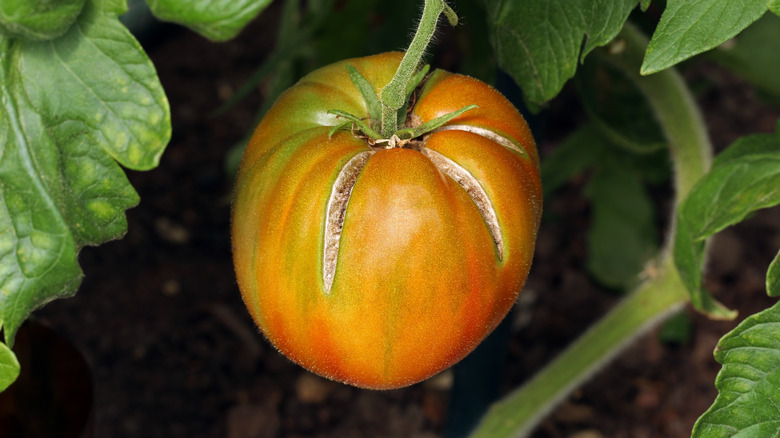How To Stop Your Tomato Plants From Splitting Once And For All
We may receive a commission on purchases made from links.
Tomatoes can be moderately difficult to grow in a home garden because of their short harvest window and vulnerability to problems. Cracking or splitting, for example, are pretty common occurrences, and they can expose the fruit to disease and pests, rendering them inedible. While split tomatoes are still safe to eat as long as they don't display signs of disease, pests, or rotting — such as a sour smell or a mushy, soft texture — the best way to prevent tomato plants from splitting is to water them just right.
How often you water common vegetables and fruits has a major impact on how they grow, and in the case of tomatoes, this determines whether or not the skin will split open in either radial or vertical cracks. Overwatering them when they're nearly mature is the most common culprit of cracking. That's because the flesh of the fruit grows faster than the skin, and the skin eventually bursts. So, keep in mind that tomato plants only need 1 to 2 inches of water per week.
As for how to water your tomato plants to prevent splits, use a soaker hose rather than a handheld hose or watering can. This ensures that the water gets deep into the ground where the roots grow and keeps the water off the leaves (wet leaves can encourage disease). Some gardeners, though, sow their tomatoes in containers so that excess water can escape. Also, it's helpful to till the soil at least 12 inches deep before planting for proper water flow.
Prevent moisture and nutrient loss to keep your tomato plants from splitting
Overwatering isn't the only reason tomato skin cracks. Wide fluctuations in soil moisture can cause this, too. Perhaps you forgot to water your tomatoes and then watered them too much once you remembered. On the other hand, maybe your garden experienced a heat wave, which dried out the soil through increased water evaporation.
In cases like these, try adding 2 or 3 inches of compost or mulch around the plants' base. Alternatively, some gardeners like to move their tomato plants indoors so they can finish ripening on the vine in a more controlled environment. You can even pick the fruits before they fully ripen and set them on a sunny windowsill to finish maturing. Meanwhile, serious gardeners like to manage soil moisture and cracking during heavy rainfall by covering their tomatoes.
Proper soil nutrition is also essential to help tomato plants grow without splitting. More specifically, tomatoes need a balanced amount of nitrogen, potassium, and calcium. Too much nitrogen can cause leaf overgrowth, and a simple soil test kit (like this New Test version on Amazon) can help you determine your nutrient levels. Interestingly, kitchen scraps can help your garden tomatoes flourish by releasing nutrients into the soil as they decompose. Banana peels and eggshells, for instance, are rich in potassium and calcium, respectively. Even growing companion plants alongside tomatoes can help them grow better. Marigolds and nasturtiums are particularly useful because they deter parasites and pests that feed off the nutrients tomatoes need.

